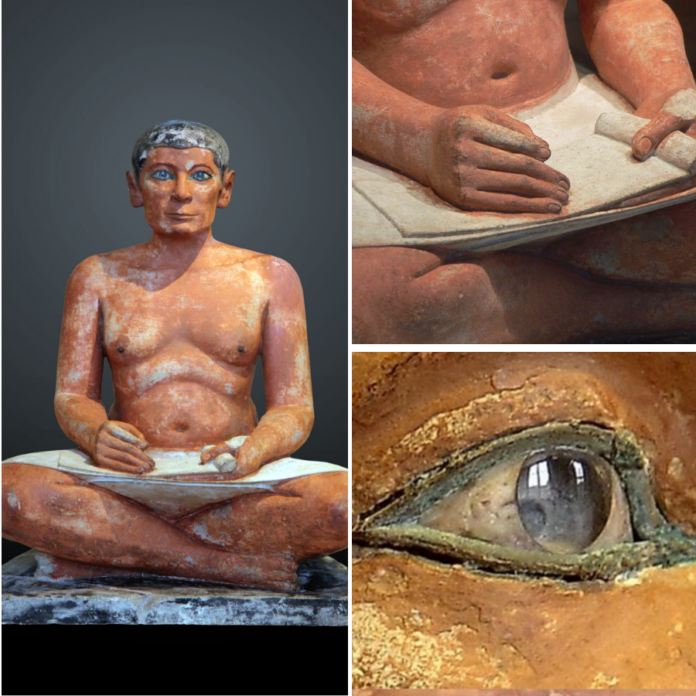The ‘Seated Scribe’ is one of the most renowned sculptures of ancient Egypt, celebrated for its realism and attention to detail. Currently housed in the Louvre Museum in Paris, this iconic piece dates back to the Old Kingdom, either the 4th Dynasty (2620–2500 BCE) or the 5th Dynasty (2450–2325 BCE). Found in Saqqara in 1850 by French archaeologist Auguste Mariette, the ‘Seated Scribe’ offers a fascinating glimpse into the artistic, cultural, and societal values of ancient Egypt.
Discovery and Historical Context
The ‘Seated Scribe’ was unearthed on November 19, 1850, during excavations led by Mariette in Saqqara, an ancient necropolis near modern-day Cairo. The precise location of the find remains uncertain due to the loss of original excavation records. However, the sculpture is believed to have been discovered near the line of sphinxes leading to the Serapeum of Saqqara, a site of immense cultural and religious significance.
Dating to the Old Kingdom, this period marked a flourishing of Egyptian art, architecture, and statecraft. The ‘Seated Scribe’ reflects this era’s dedication to realism in art, emphasizing the individuality of the subject while adhering to symbolic and functional elements typical of ancient Egyptian sculpture.
Materials and Craftsmanship
The craftsmanship of the ‘Seated Scribe’ is a testament to the advanced skills of ancient Egyptian artisans. The statue is made of painted limestone, with wooden nipples and intricately inlaid eyes. These eyes are composed of red-veined white magnesite and polished rock crystal, giving them an almost lifelike quality. Behind the crystal, an organic material imparts a striking blue hue to the iris and acts as an adhesive. Two copper clips securely hold the eyes in place, showcasing the meticulous attention to detail employed by the sculptor.
The eyebrows are outlined with fine lines of dark organic paint, enhancing the figure’s expressive features. The combination of materials—stone, crystal, copper, and wood—demonstrates the diverse resources and techniques available to Egyptian artists of the time.
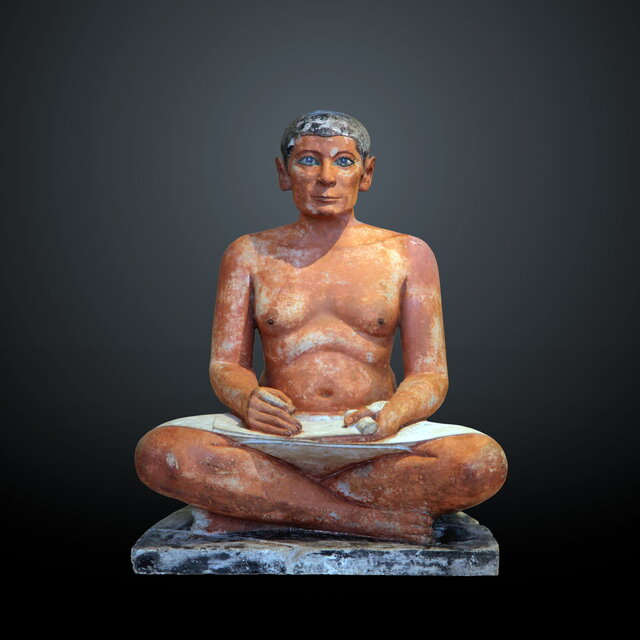
Artistic Features
One of the most remarkable aspects of the ‘Seated Scribe’ is its realism, particularly evident in the face. The sculpture’s delicate features, including the well-defined cheeks, slightly curved lips, and outlined eyes, create an impression of alertness and attentiveness. The scribe’s gaze appears to meet the viewer directly, suggesting he is ready to engage or respond.
In contrast to the detailed face, the body is somewhat simplified but no less expressive. The scribe is depicted with a slightly soft and overweight physique, an intentional choice by the artist to convey his wealth and privileged position. Unlike laborers or soldiers, whose statues often emphasize muscular strength, the scribe’s body reflects a life of intellectual work rather than physical labor.
The hands are another standout feature, intricately modeled to show fine details, such as fingers and fingernails. Positioned on the lap, the right hand points toward a papyrus scroll, indicating he is mid-task. Although the reed-brush he would have used to write is missing, the posture and positioning of the hands capture the essence of his profession.
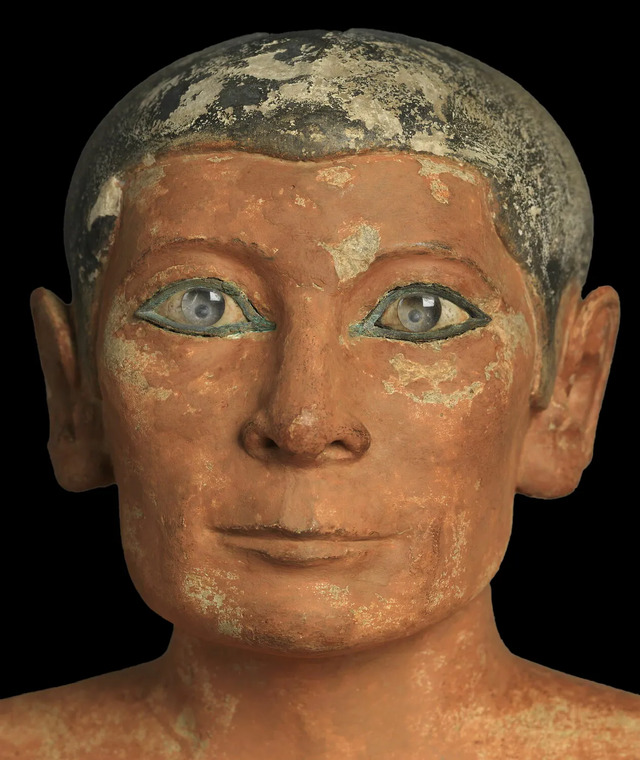
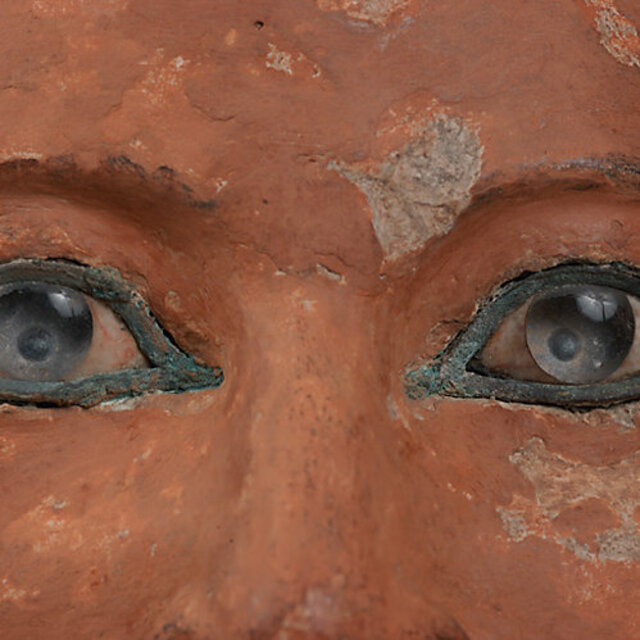
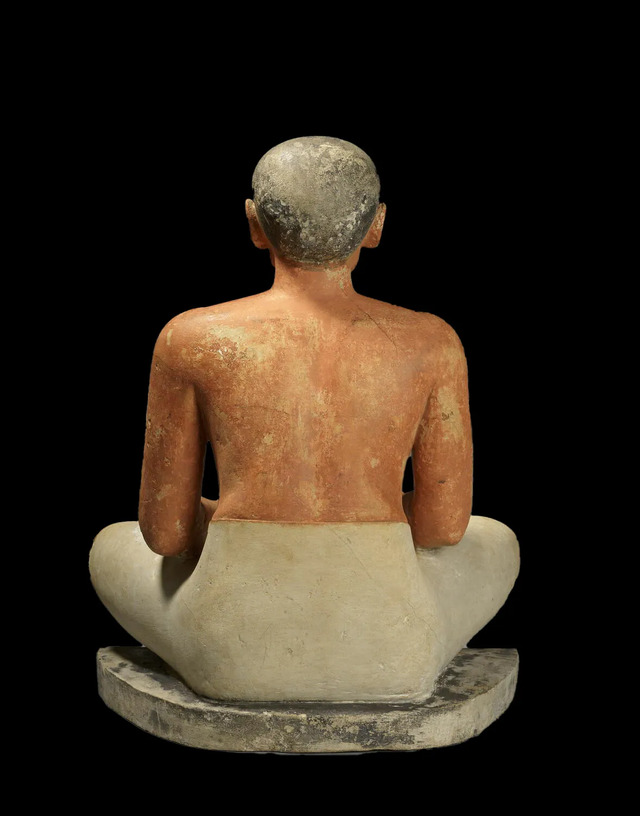

Symbolism and Representation
The ‘Seated Scribe’ is rich with symbolism, offering insights into the societal structure and cultural values of ancient Egypt. Scribes held a prestigious role, serving as record keepers and administrators in a highly bureaucratic society. The seated posture, cross-legged with a papyrus scroll on his lap, represents his work environment and professional identity.
The soft, rounded body conveys more than just physical appearance; it symbolizes wealth, comfort, and a life free from manual labor. The attention to the figure’s dress, a white kilt extending to the knees, further emphasizes his status. This meticulous representation serves not only as a realistic portrait but also as a celebration of the scribe’s essential role in Egyptian society.
The facial expression, calm yet focused, reflects the intellectual nature of the scribe’s work. The direct gaze, enhanced by the lifelike inlaid eyes, creates a sense of connection between the sculpture and its viewer, as though the scribe is waiting for instructions or preparing to record important information.
Preservation and Legacy
The ‘Seated Scribe’ has survived remarkably well, allowing modern audiences to appreciate its artistic and cultural significance. Despite its age, the statue retains much of its original paint and detail. However, some aspects of its discovery remain mysterious due to the loss of Mariette’s excavation journal. The lack of precise documentation about the statue’s original context has not diminished its importance but has instead added an element of intrigue.
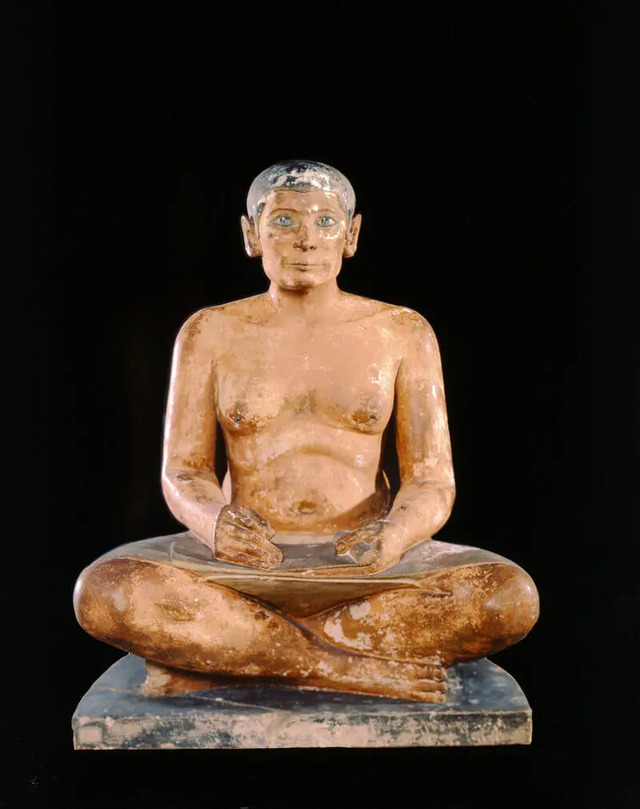
Over the years, the ‘Seated Scribe’ has become a cornerstone of ancient Egyptian art, studied and admired by scholars and visitors alike. Its realism and attention to detail stand out in comparison to more rigid and idealized depictions of Egyptian royalty. The statue represents a shift toward individualism in art, highlighting the subject’s unique characteristics while maintaining symbolic elements.
Conclusion
The ‘Seated Scribe’ remains a masterpiece of ancient Egyptian art, celebrated for its lifelike features, symbolic depth, and technical brilliance. As one of the most studied artifacts from the Old Kingdom, it provides invaluable insights into the cultural and societal values of ancient Egypt. Through its realistic craftsmanship and symbolic representation, the sculpture bridges the gap between art and life, offering a timeless connection to a civilization that continues to fascinate the modern world.
